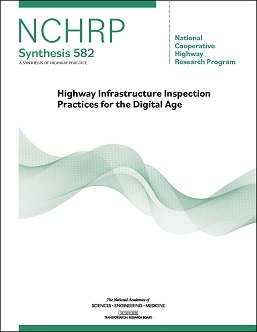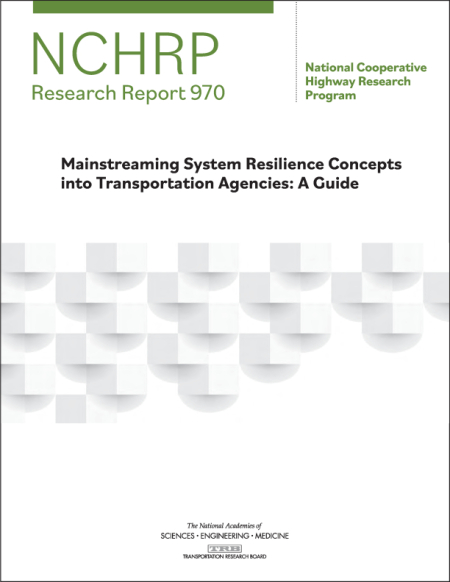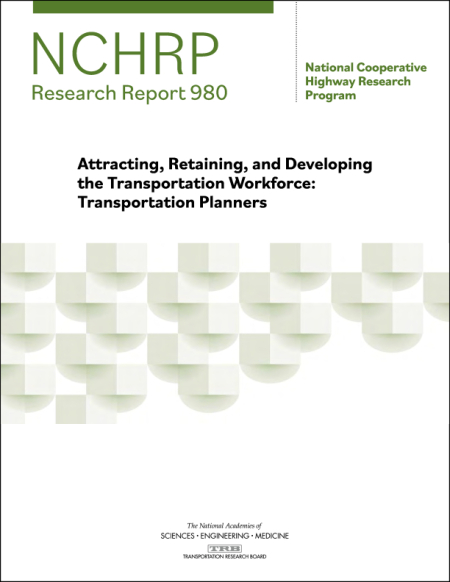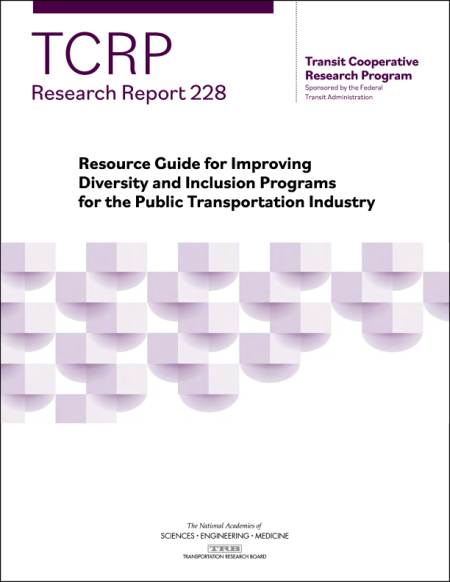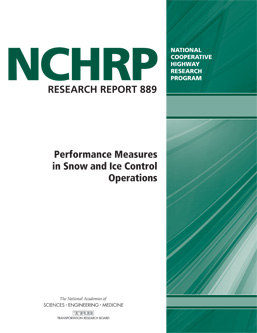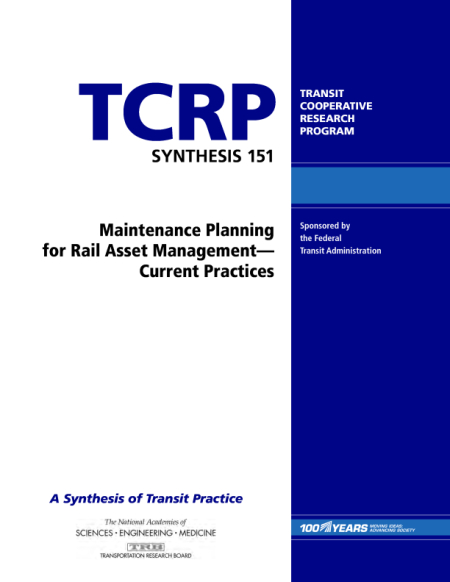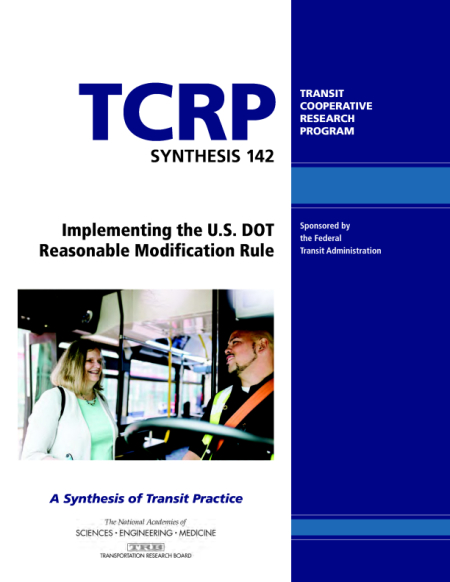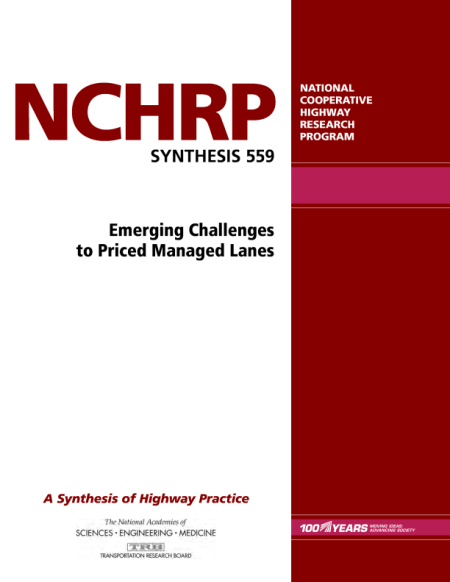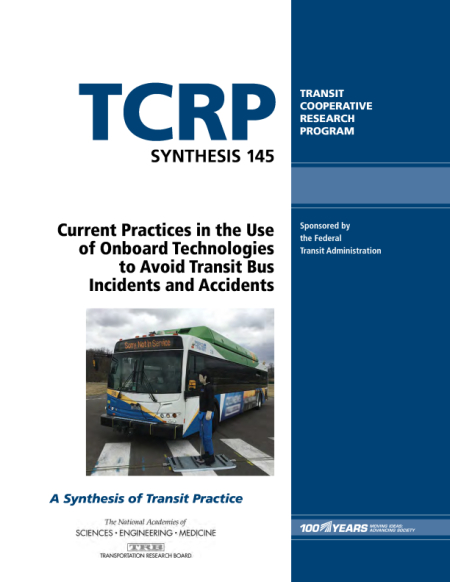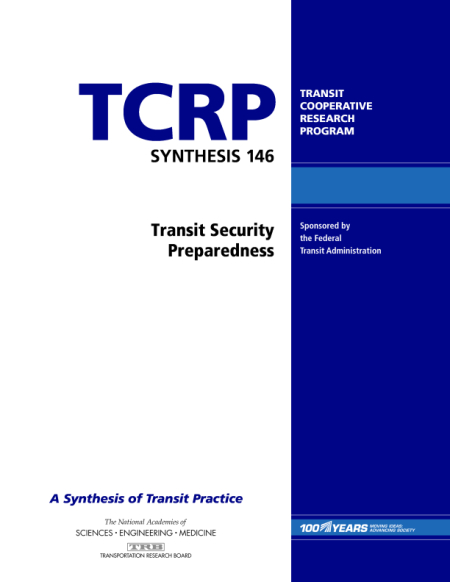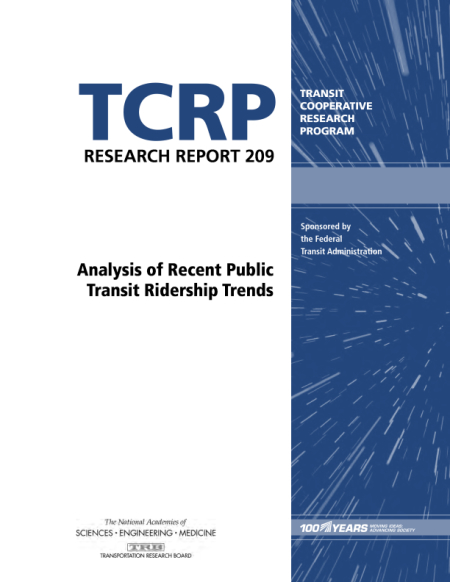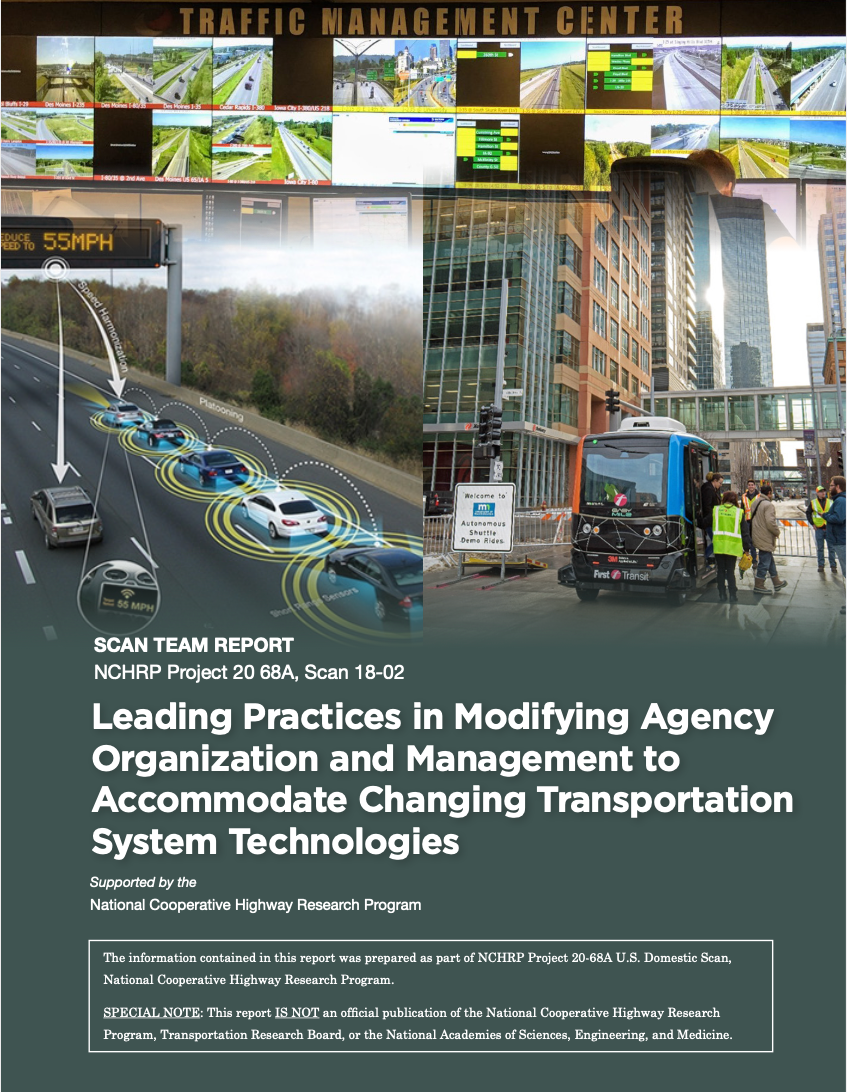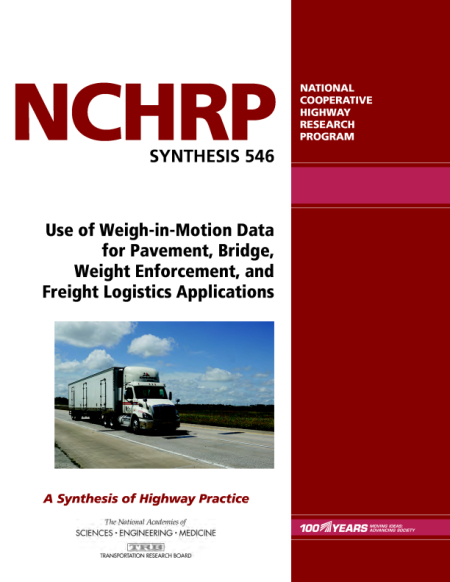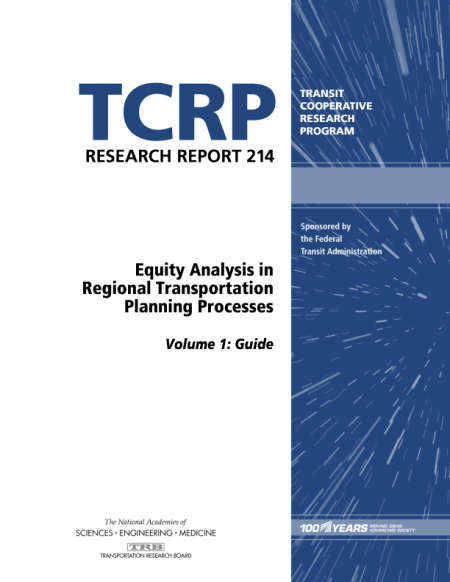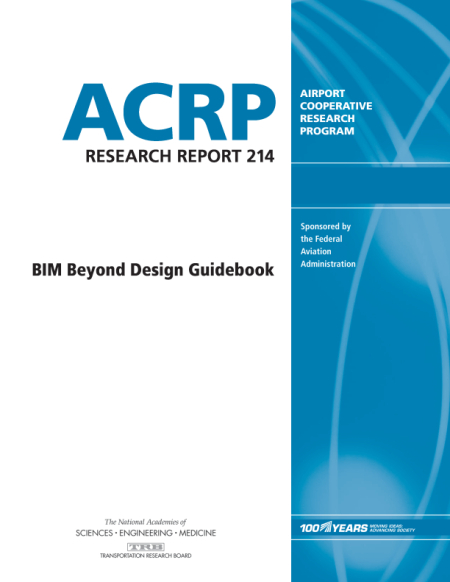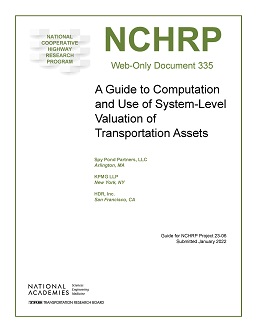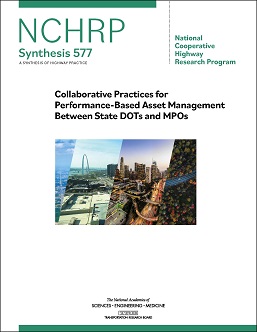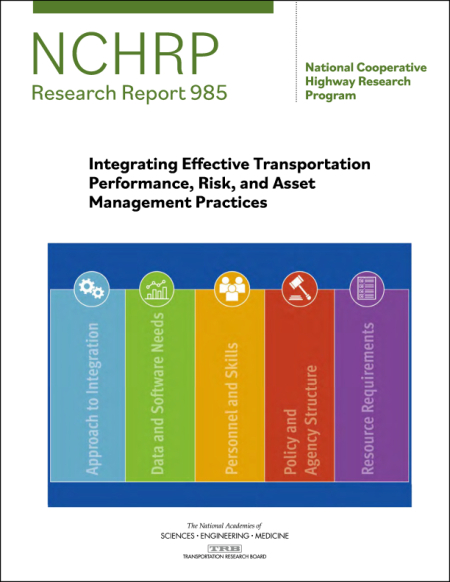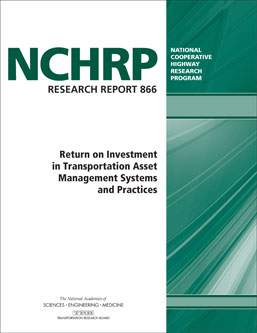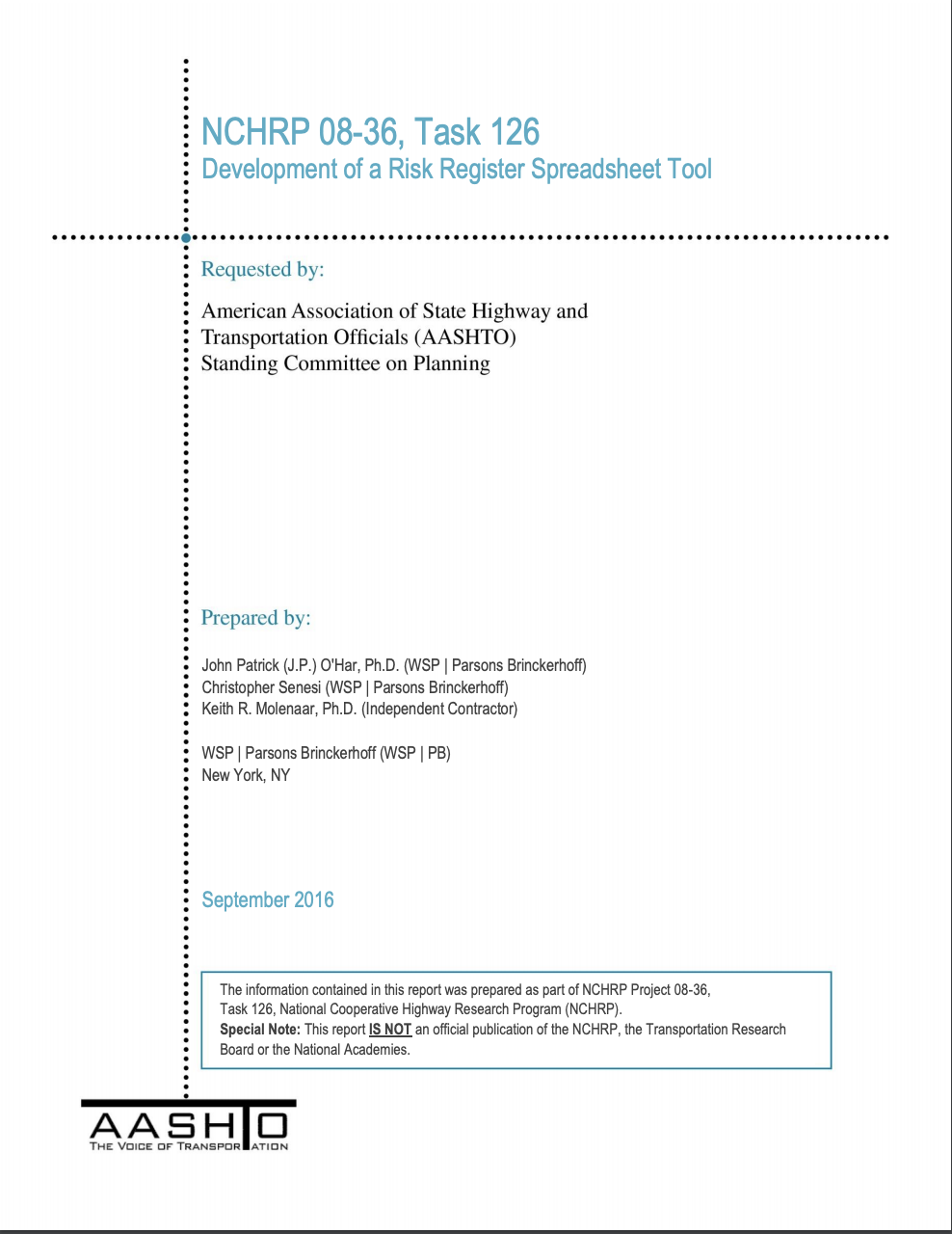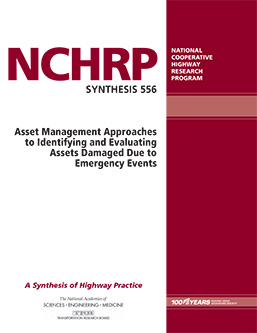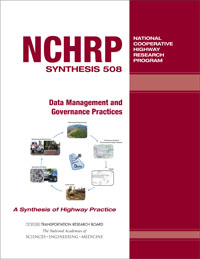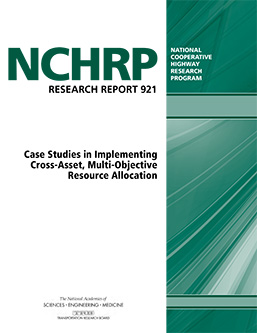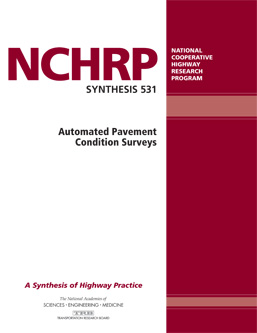Collection: NCHRP Reports
Collection: NCHRP Reports
Description
NCHRP Reports are the main product of NCHRP research projects and are often written as guidebooks or manuals. This collection features all of the NCHRP Reports posted on the TAM Portal to date.
To search the resources by state either click on the state from the map or select a state from the dropdown under search filters.
Highway Infrastructure Inspection Practices for the Digital Age (2022) | Research Report
This report details the deployment of state-of-the-art technology for the inspection of highway infrastructure during construction and maintenance activities.
Mainstreaming System Resilience Concepts into Transportation Agencies: A Guide | Research Report
This guide contains a self-assessment tool for gauging the status of transportation system resilience by incorporating resilience concepts into the decision-making framework.
Attracting, Retaining, and Developing the Transportation Workforce: Transportation Planners | Guide/Manual
Organizational ManagementThis NCHRP report presents an assessment of the current and emerging forces shaping transportation planning practice and the transportation planning workforce. The objectives of this research were to (1) identify the knowledge, skills, abilities, education, and experience (KSAEEs) required for plan making and talent profiles for state, regional, and local transportation planners that are aligned with existing and emerging agency needs; and (2) provide guidance on how agencies can attract, develop, manage, and retain planning talent.
Guide to Pedestrian Analysis | Research Report
Safety, System PerformanceThe NCHRP Research Report 992: Guide to Pedestrian Analysis spells out several methods for conducting pedestrian traffic analyses. The report identifies analyses based on volume, safety, operations, and service quality. All of these analyses form a broader picture focused on improving active transportation and multimodal transportation in cities and regions around the country. The report presents evaluation methods which align with the Highway Capacity Manual. In addition to the report content, the researchers also developed and identified supplemental resources including presentations from a peer exchange workshop, computational engines, and an additional report on HCM pedestrian methods for sustainable and safe communities.
Implementation of the AASHTO Guide for Enterprise Risk Management | Research Report
This report presents pilots with three different agencies as they applied the strategies and practices identified in the AASHTO Guide for Enterprise Risk Management and smaller case studies from several more agencies. Many agencies mitigate risk on a daily basis without realizing or formalizing the process. This study seeks to raise awareness for systematic risk management across the agency including a risk community of practice, peer exchanges, webinars, and outreach. Checkout the report to learn more about the process of risk management and how it helped out these agencies. Alongside the report, the researchers also produced a presentation, a risk assessment tool, a budget template and a webinar video, all available from the external link.
Document
Mar 2022
Reducing Greenhouse Gas Emissions: A Guide for State DOTs | Research Report
Emissions, EnvironmentThis WebResource describes methods State DOTs may implement to assess and reduce their GHG emissions. The resource includes self-assessment tools, an overview of climate change issues, a framework for addressing GHG emissions, and numerous resources and links. The report organizes around nine functional areas of the agency, with cross-cutting topics to pull it all together. Through the discussions, tools, and resources in each section, the report provides support for reducing emissions across all stages of a project, from policy and planning to construction and maintenance. It also reviews stakeholder communication, partnerships with other agencies, and federal or state requirements. Readers may use this guide and its flexible presentation for addressing specific areas within an agency or to adopt an agency-wide approach.
Measuring the Effectiveness of Public Involvement in Transportation Planning and Project Development | Research Report
Organizational ManagementThis research report develops a toolkit for transportation practitioners to measure the effectiveness of an agency's public involvement. A score is developed based on a couple different indicators and the agency's own perceptions. The toolkit may be used to compare different public involvement strategies and track an agency's performance over time.
Resource Guide for Improving Diversity and Inclusion Programs for the Public Transportation Industry (2021) | Research Report
System PerformanceThis knowledge explores initiatives undertaken by transit agencies across the country to improve diversity and inclusion within the industry. The report documents how these programs have evolved over the last 20 years and how they have been successful. In addition to the research report, this document also includes a toolkit and guidance for implementing diversity programs as well as a series of additional resources.
Performance Measures in Snow and Ice Control Operations | Research Report
System PerformanceThis report outlines approaches for monitoring performance for snow and ice control activities, and suggests a set of performance measures that should be used in the monitoring process.
Maintenance Planning for Rail Asset Management | Case Study/Practice Example, Research Report
Asset ManagementThis TCRP Synthesis report presents an analysis of the current practices in rail asset management from the industry at large. The findings are based on the results of a survey of 28 heavy- and light-rail transit agencies across the US and three selected case studies. Specifically, this study looks at the rate of occurrence of rail defects, broken rails, and broken rail derailments and how that corresponds to the use of ultrasonic testing by agencies of different sizes and levels of transit system use.
Implementing the U.S. DOT Reasonable Modification Rule | Case Study/Practice Example
AccessibilityThis synthesis report assembles and shares the current state of practice for the implementation of the 1990 ADA regulation in transit systems. It documents examples from six transit systems as they make modifications to support individuals with disabilities and meet the expectations of the legislation. It also mentions future research needs in this area.
Collecting and Sharing of Operations and Safety Data (ACRP Research Report 222) | Research Report
SafetyThis report presents an essential component of an airport's risk management data process: collecting and sharing operations and safety data. Such data helps airports monitor their performance and benchmark against the industry. To aid airports in this endeavor, this report identifies best practices and data sources for collecting such data. It also explains some of the challenges associated with the process and outlines a plan for a future national database.
Emerging Challenges to Priced Managed Lanes (NCHRP Synthesis 559) | Research Report
Asset Management, PavementA comprehensive review of the challenges of implementing managed lanes from the perspective of state DOTs is presented in this research report. The review covers much of the available literature (60 publications and over 700 media articles), a survey sent to 50 state DOTs, and six relevant case studies. With an often highly dubious public, there is quite a wide gap between the goals of DOTs' managed lanes and the public's assumptions. This research seeks to understand that gap and present best practices for overcoming the challenges facing tolling or pricing on managed lanes.
Current Practices in the Use of Onboard Technologies to Avoid Transit Bus Incidents and Accidents (TCRP Synthesis 145) | Case Study/Practice Example, Research Report
SafetyTCRP Synthesis 145 gathers and analyzes many of the best current practices for preventing incidents and accidents on transit buses. Their study identifies the most common and most effective technologies including a number of collision avoidance technologies such as forward collision warning, emergency braking, lane departure warnings. and electronic stability control.
Transit Security Preparedness (TCRP Synthesis 146) | Case Study/Practice Example
Transit Security Preparedness identifies practices transit agencies can use to improve their security to reduce their security risks, with a specific emphasis on practices related to new technologies. The report presents common themes in the approaches to security preparedness to aid transit agencies as they develop a process that fits their needs.
Analysis of Recent Public Transit Ridership Trend (TCRP Research Report 209) | Research Report
Accessibility, Mobility, System PerformanceThis research report presents a snapshot of the trends facing public transportation and tested strategies for counteracting transit ridership decreases. The research method includes a literature review, analysis of current transit ridership levels, and ten case studies.
Reliability of Crash Prediction Models: A Guide for Quantifying and Improving the Reliability of Model Results (NCHRP Research Report 983) | Research Report
SafetyThis research report supports the AASHTO Highway Safety Manual by establishing the methods for ensuring reliable results in crash prediction models.
Guidelines for the Development and Application of Crash Modification Factors (NCHRP Research Report 991) | Research Report
SafetyThis research report outlines a procedure for using crash modification factors (CMFs) to understand and quantify the effect of a transportation investment on the system. The report dives into great detail on how to select and adjust CMFs for different pavement and bridge assets, how to apply the CMFs in investment decisions, and how to develop new CMFs that account for important factors relating to the location and asset type.
Resilience Primer for Transportation Executives (NCHRP Research Report 976) | Research Report
Environment, Safety, System PerformanceTransportation resilience comes in many forms, including natural disasters, unexpected infrastructure failures, and cyber attacks. Transportation agencies and the executives who lead them must be prepared to act quickly and efficiently to restore service to the system when adverse events occur. This brief report covers how CEOs can improve the resiliency of their organization through operational and strategic planning and strong understanding of the technical and policy factors.
Guidebook for Effective Policies and Practices for Managing Surface Transportation Debt | Research Report
EconomyPaying for capital transportation projects is a major challenge for many state agencies, made more complex by the passage of Dodd-Frank and the COVID-19 pandemic. This report guides practitioners through the process of debt-financing. It clearly describes the federal regulations, economics, federal institutions, and program needs that govern debt issuance and management, and it goes into great detail for each phase of the debt-financing process. The four phases are the decision process, individual transaction preparation & development, marketing & placement of individual transactions, and post-issuance compliance strategy. Three key challenges are also addressed in the guidebook: accessing complete information, planning for economic uncertainty, and adapting to technological advances.
Transportation System Resilience: Research Roadmap and White Papers (NCHRP Research Report 975) | Research Report
Economy, Environment, System PerformanceThis research report, published in 2021, highlights the knowledge gaps within the transportation industry pertaining to transportation system resilience strategies and plans. The report outlines a five-year research plan to address these shortcomings and presents the critical resilience-related issues facing practitioners today.
Rural Transportation Issues: Research Roadmap | Research Report
Asset Management, System PerformanceThis research roadmap for rural transportation identifies a series of research needs statements and projects encapsulated within a long-term research vision. Their studies reflect the opinions of a number of different rural transportation stakeholders and communities, and the topics include everything from aviation & marine transportation to transportation administration & management to intercity transit & active transportation. The purpose of this research is to support policy-driven investment and improve the safety and efficiency of the US rural transportation network.
Leading Practices in Modifying Agency Organization and Management to Accommodate Changing Transportation System Technologies | Research Report
Environment, System PerformanceThis report focuses on organizational structures and management approaches which engender collaboration and communication within DOTs and result in the adoption of new technologies and innovative programs. The scan team interviewed various aspects of leadership, culture and organization at Utah, Maryland, Washington State, Tennessee, Iowa, and Minnesota DOTs to uncover their methods for success. The results of the interviews are organized into: leadership and cultural traits; peoples' knowledge, skills, and abilities; organizational structures; business process improvements; performance management; and collaboration.
Use of Vehicle Probe and Cellular GPS Data by State Departments of Transportation (NCHRP Synthesis 561) | Case Study/Practice Example, Research Report
This NCHRP Synthesis report presents nineteen case examples from a range of different agencies exploring the application of vehicle probe and cellular GPS data in transportation applications. Commonly used for planning, monitoring, and real-time information, these new technologies have many barriers and benefits which are covered in this research document.
The synthesis report is divided into three sections. First is a literature review over the history, technology, and use of probe and cellular GPS data. In the second section, the literature results are combined with the expertise of panel members and a survey distributed to 51 DOTs. The final section contains the findings of follow-up interviews with selected agencies and documents specific case studies.
Guidebook for Managing Data from Emerging Technologies for Transportation | Research Report
Asset Management, System PerformanceAs new technologies are developed in the field of transportation, agencies have the opportunity to collect more data than ever before. In this report, agencies are introduced to an eight step framework for managing this new big data and incorporating it into asset management. The eight steps start with gaining an understanding of big data, then walk through the process for piloting a big data test environment. The steps end with demonstrating the value of the data to other business units and executives and set up a formal storage environment. Supporting this report are several additional tools, including a data management capability self-assessment, a catalog tool, and more information on data governance.
Use of Weigh-in-Motion Data for Pavement, Bridge, Weight Enforcement, and Freight Logistics Application | Research Report
Asset Management, Bridge, PavementThis synthesis report presents the use of weigh-in-motion (WIM) data to better design and maintain pavement and bridge assets. The report relies on a survey of state DOTs, a literature review, and five detailed case studies from California, Minnesota, Florida, Maryland, and Tennessee to demonstrate the value in applying this data to asset management.
Equity Analysis in Regional Transportation Planning Processes, Volume 1: Guide | Guide/Manual
System PerformanceThis guide helps agencies to incorporate equity into their transportation plans through a five-step framework for conducting equity analyses. The five steps are: identifying populations for analysis, identifying needs and concerns, measure impacts of proposed agency activity, determine if impacts are disparate or have adverse effects, and develop strategies to avoid and mitigate inequities. Though intended for Metropolitan Planning Organizations (MPOs), this guide is also applicable to transit agencies, state DOTs, and other transportation agencies that seek to address equity in their plans, programs, and policies.
Performance Metrics for Public–Private Partnerships (NCHRP Synthesis 563) | Research Report
System PerformancePublic-private partnerships (P3) offer transportation agencies a method for designing, building, operating, and maintaining their assets without having to wait for government funding. To ensure contract compliance and performance, agencies use a variety of different metrics to monitor their P3 contracts. Metrics usually fall into two main categories: quantifying asset performance and project implementation. This report presents such metrics used by DOTs. Data was sourced from a survey of 26 DOTs and interviews with DOT personnel on six P3 projects.
Minutes Matter: A Bus Transit Service Reliability Guidebook (TCRP Research Report 215) | Guide/Manual
System PerformanceReliability is an increasingly important measure for transit performance as transit must compete with other mobility service providers. In this guide, public transit agencies and and other stakeholders are instructed on the value of measuring reliability and how to address the reliability issues for several different environments. The guide examples focus on fixed-route bus service, as it is the most common mode of transit in the US and globally, but the methodology may be applied to other modes as well. It presents the three key components of reliability: short wait times, on-time arrivals, and consistent travel times. Three perspectives are also addressed in the guide; these are customer, agency, and operator perspectives.
Planning and Implementing Multimodal, Integrated Corridor Management: Guidebook | Guide/Manual
Asset Management, System PerformanceThis guidebook presents Integrated Corridor Management (ICM), which is a multimodal and multi-agency method for coordinating the operations of a corridor, including highways, arterial roads, and transit systems. Through the use of technology, data, and multi-agency institutional frameworks, ICM helps mitigate the challenges of congestion along key corridors. This guide highlights why agencies should use ICM and walks through the process for applying it.
Broadening Integrated Corridor Management Stakeholders (NCHRP Research Report 899) | Guide/Manual
Freight, Mobility, System PerformanceThrough its coordinated approach, Integrated Corridor Management (ICM) optimizes the use of assets and flow of traffic along a corridor. This guide presents a more inclusive, systematic approach to ICM, accounting for the stakeholders often left behind in traditional ICM: freight, transit, incident response, and non-motorized transportation users. The new methods are based on the feedback and lessons learned of agencies that have implemented ICM.
Update of Security 101: A Physical Security and Cybersecurity Primer for Transportation Agencies (NCHRP Research Report 930) | Research Report
Asset Management, SafetyNCHRP Research Report 930 provides an update to the Security 101 report released in 2009. The update includes current advancements in transportation security and the constantly evolving threats facing transportation agencies, specifically cyber-attacks. The seven chapters of this guidebook cover fundamental parts of strategies, management tactics and planning for physical and cyber security. Chapter 1 covers risk management and assessment. Chapter 2 provides the components of a security plan. Chapters 3 and 4 cover countermeasures and the specifics of cybersecurity, respectively. Chapter 5 presents trainings and exercises for preparing the agency workforce, and chapter 6 discusses the protection of infrastructure with an increased focus on resilience. Lastly, chapter 7 reviews laws and directives from the federal government.
A Guide to Emergency Management at State Transportation Agencies (NCHRP Research Report 931) | Research Report
Safety, System PerformanceThis guide provides an update to the 2010 guidebook (NCHRP Report 525: Surface Transportation Security, Volume 16) to include new federal guidance and advancements in practices. It assists executive management and emergency response planners in completing all aspects of the planning, preparation, and delivery of their agency's emergency management tasks. The guide complies with NIMS, covers all levels of hazards and all modes of travel, and focuses on the safety of system users and disaster responders.
A Pandemic Playbook for Transportation Agencies (NCHRP Research Report 963/TCRP Research Report 225) | Research Report
Safety, System PerformanceIn light of the COVID-19 pandemic, this research report covers the impact of pandemics on transportation agencies of all sizes and how best to approach the challenges created. The guide identifies several challenges including public fear and loss of confidence in safety, morale and trust issues with employees, loss of team building and team interactions, stress and other psychological impacts, funding and increased expenses, and other unintended consequences of response actions. It highlights a series of key questions to ask when developing a response to pandemic events, and it runs through emergency management plays for a slew of different areas.
BIM Beyond Design Guidebook (ACRP Research Report 214) | Guide/Manual
Asset ManagementThis guide to building information modeling (BIM) applications for airports was published in 2020. It presents guidance for evaluating the business case of applying and implementing BIM.
Lessons Learned and Impacts to Date of State DOT Implementation of New Federal Transit Asset Management and Public Transportation Agency Safety Requirements | Research Report
Asset ManagementThe objectives of this research are to document (1) the state of practice within state DOTs as they implement these new requirements and (2) the impacts of implementation to date on asset condition, safety performance and the investment of federal transit funds. This research will provide states with information that will help them evaluate the effectiveness of their efforts to date and refine or adjust their implementation.
A Guide to Computation and Use of System Level Valuation of Transportation Assets | Document
Asset ManagementState transportation agencies are stewards for public infrastructure assets that are essential to economic vitality, public safety, and quality of life. Accurate, relevant, and reliable asset valuation is crucial for decision-making to ensure the effective, efficient, and economical management of these public assets.
The Guide to Computation and Use of System Level Valuation of Transportation Assets provides guidance on how to calculate asset value, including three different perspectives each suited to different purposes, and a simple, 6-step approach to conduct the computation. It should be noted that though this guide is consistent with the standard practices, it is not an official accounting or financial standard.
Web resources available at https://www.assetvalueguide.com
The web guide is a product of NCHRP Project 23-06 presented in an easy-to-navigate digital version. The guide aids TAM practitioners in calculating and communicating asset value for an array of different perspectives and incorporating asset value into their decision-making processes. It is applicable to both highway and transit modes, and it provides advice for the best methods to value various different assets and asset classes.
Collaborative Practices for Performance-Based Asset Management between State Transportation Agencies and Metropolitan Planning Organizations | Document
Asset ManagementThe objective of this synthesis is to document DOT collaboration with MPOs relative to target setting, investment decisions, and performance monitoring of pavement and bridge assets for performance-based planning and programming. The synthesis will focus on DOT practices to initiate and facilitate collaboration with MPOs.
NCHRP Report 956 – Guidebook for Data and Information Systems for TAM | Guide/Manual
Asset ManagementThe objective of this research is to develop a guidebook presenting principles, organizational strategies, governance mechanisms, and practical examples for improving management of the processes for collecting data, developing useful information, and providing that information for decision making about management of the transportation system assets. The guide comprises a pre-assessment, a guided self-assessment, an evaluation of the results, and implementation support. Additionally it includes a glossary of key terms and case studies highlighting different parts of the process.
To access the online version of this report, please click here.
Integrating Effective Transportation Performance, Risk, and Asset Management Practices (NCHRP Research Report 985) | Research Report
Asset ManagementNCHRP Research Report 985 presents a flexible process framework for fully integrating the performance, asset, and risk management across an agency. The process outlined in the report may be uniquely adapted to each agency's current and future needs. It includes five key areas for management integration: approach to integration, data and software needs, personnel and skills, policy and agency structure, and resource requirements.
Return on Investment in Asset Management Systems and Practices | Document
Asset Management, Bridge, PavementThis report presents guidelines to transportation agencies for the management of their assets related to return on investment. The details in the report rely upon the work conducted by the research team and their experiences. It is published alongside a spreadsheet tool which helps agencies evaluate their simulations of return on investment for TAM.
Development of a Risk Register Spreadsheet Tool | Document
This document provides an explanation of the steps taken to develop the risk register tool. The research team conducted a survey of current practices for risk management across state DOTs, international agencies, and non-transportation organizations. Then they built a draft tool and received user feedback before finalizing the tool.
Asset Management Approaches to Identifying and Evaluating Assets Damaged Due to Emergency Events | Research Report
Asset Management, Bridge, PavementNCHRP Synthesis 556 summarizes state DOT practices used to identify pavement and bridge asset locations repeatedly damaged by emergency events and to mitigate the risk of recurring damage in those locations. The synthesis focuses particularly on mitigation practices that concurrently advance TAM and TPM objectives. Information for this synthesis was gathered through a literature review, a survey of state DOTs, and follow-up interviews with selected agencies.
Data Management and Governance Practices (NCHRP Synthesis 508) | Research Report
This report develops a collection of transportation agency data management practices and experiences. The report demonstrates how agencies currently access, manage, use, and share data.
Case Studies in Cross-Asset, Multi-Objective Resource Allocation (NCHRP Report 921) | Guide/Manual, Research Report
This report extends and implements the results of NCHRP Report 806: Cross-Asset Resource Allocation and the Impact on System Performance. Case studies were used to illustrate key issues in implementing a cross-asset resource allocation approach, and the lessons learned were then used to improve the guidance and tools developed in NCHRP Report 806.
Geotechnical Asset Management for Transportation Agencies, Volume 2: Implementation Manual (NCHRP Report 903) | Research Report
This report presents a manual that can be used to implement Geotechnical Asset Management (GAM) planning.
There are several downloadable files that accompany Volume 2.
http://onlinepubs.trb.org/onlinepubs/nchrp/nchrp_rpt_903_appendices.pdf
http://onlinepubs.trb.org/onlinepubs/nchrp/nchrp_rpt_903_gamtool.xlsm
http://onlinepubs.trb.org/onlinepubs/nchrp/nchrp_rpt_903_template.xlsx
http://onlinepubs.trb.org/onlinepubs/nchrp/nchrp_rpt_903_presentation.pptx
A Guide to Developing Financial Plans and Performance Measures for Transportation Asset Management (NCHRP Report 898) | Research Report
Asset ManagementThis report presents guidance for state departments of transportation (DOTs) and other agencies conducting financial analyses and developing financial plans to support efficient and effective management of the agency’s transportation assets.
Automated Pavement Condition Surveys (NCHRP Synthesis 531) | Research Report
Asset Management, PavementThis synthesis report documents agency practices, challenges, and successes in conducting automated pavement condition surveys. The report also includes three case examples that provide additional information on agency practices for conducting automated pavement surveys.
Benchmarking and Comparative Measurement for Effective Performance Management by Transportation Agencies | Research Report
This report presents guidance and examples for selection of peer groups to ensure that benchmarking is effectively applied to enhance transportation system performance. The report includes practical guidance on how transportation agencies can undertake benchmarking to improve system performance management practices and highlights applications of the guidance in two specific components of system performance, for active (that is, non-motorized) transportation and environmental impact.
Investment Prioritization Methods for Low-Volume Roads (NCHRP Synthesis 521) | Research Report
Asset Management, Bridge, PavementThis report documents current practices used by transportation agencies to make investment decisions about low-volume roads. Current transportation asset management practices for low-volume roads typically use asset condition, traffic, and safety metrics to prioritize investment decisions for preservation, maintenance, repair, and replacement projects. However, these metrics do not fully measure the significant value for the wider economy and society that low-volume roads can provide.
Management and Use of Data for Transportation Performance Management: Guide for Practitioners | Research Report
System PerformanceThis report provides practical guidance to transportation agencies to help improve their use of data for performance management. Recent federal legislation has highlighted the importance of data utilization in performance management. The guidance focuses on six areas of the data life-cycle allowing for analysis on decisions and to identify opportunities for improvement. The purpose of this report is to allow for agencies to enhance their insight into their performance and to boost results.
Performance Management Reporting Peer Exchange Final Report – NCHRP Project 20-24 Task 124 | Document
Asset Management, PavementThe NCHRP 20-24 Task 124 Performance Management Reporting Peer Exchange was held on Tuesday October 16th and Wednesday October 17th, 2018 at the Hall of States in Washington D.C. Representatives from 18 state DOTS, the Federal Highway Administration (FHWA), the American Association of State Highway and Transportation Officials (AASHTO) and the Transportation Research Board (TRB) attended. Participants were subject matter experts in performance management, pavement management and communications. The goal of the Peer Exchange was to help DOTs develop a toolkit and strategies for communicating the difference between state and Federal pavement performance in a consistent narrative. While this Peer Exchange focused on pavement performance, the process can be used as a framework to develop strategies to help states communicate other performance measures. A toolkit and summary are available in addition to the final report.
Resilience in Transportation Planning, Engineering, Management, Policy, and Administration (NCHRP 20-05 Topic 48-13) | Research Report
This report from NCHRP Synthesis 20-05/Topic 48-13 Resilience in Transportation Planning, Engineering, Management, Policy, and Administration, explores how agencies are incorporating resilience practices through project development, policy, and design. The information gathered details the motivations behind the policies that promote highway resilience, definitions of risk and resilience, and the relationship between these two fields.
Assessing Risk for Bridge Management (NCHRP 20-07 (378)) | Guide/Manual, Research Report
Asset Management, BridgeThe objective of this research is to develop proposed AASHTO guidelines for a data-driven risk assessment at the bridge and structure level. The guidelines considered risks from natural and man-made hazards and aimed to be useful in a bridge management system.
Asset Management (NCHRP 20-07 Task 120) | Research Report
For this NCHRP Project 20-07/Task 120 Asset Management, the consultant assisted the AASHTO Task Force on Transportation Asset Management by coordinating numerous on-going activities and by contributing to the development of the AASHTO Strategic Plan for Asset Management. The consultant coordinated the business of the Task Force with the FHWA, AASHTO members, and other public and private agencies regarding the operation, improvement, and preservation of transportation assets. The consultant helped coordinate and facilitate a workshop on asset management held in Scottsdale, Arizona, on December 1-3, 1999.
Consequences of Delayed Maintenance of Highway Assets (NCHRP 14-20A) | Research Report
Asset Management, Bridge, PavementThe objective of this research, NCHRP Project 14-20A Consequences of Delayed Maintenance of Highway Assets, was to develop processes for quantifying the consequences of the delayed application of maintenance treatments on highway pavements, bridges, and other physical assets. The research expressed consequences in terms of performance indicators (e.g., distress and level of service), costs to owners and road users, and other relevant factors and defined delayed maintenance applications by (1) the inability to meet the agency-defined application schedule or (2) the available budget relative to an unconstrained budget (i.e., availability of the funds required to perform all needed maintenance).
Role of Highway Maintenance in Integrated Management Systems (NCHRP 14-09(4)) | Research Report
The objectives of this project, NCHRP 14-09(4) Role of Highway Maintenance in Integrated Management Systems, were to design an idealized Maintenance Management Information System (MMIS) based on data available from all transportation information systems and develop a guide to assist state transportation agencies in moving toward implementation.
The final report has been published as NCHRP Report 363, "Role of Highway Maintenance in Integrated Management Systems." This report outlines a framework for integrating maintenance management with other highway and administrative management functions. This framework considers the next generation of maintenance management systems, and how they must respond to the organizational, political, and technological trends that have emerged in recent years.
The report can be found at http://onlinepubs.trb.org/Onlinepubs/nchrp/nchrp_rpt_363.pdf
Guide for Optimal Replacement Cycles of Highway Operations Equipment (NCHRP 13-04) | Guide/Manual, Research Report
The objective of this research, NCHRP 13-04, was to develop a Guide for Optimal Replacement Cycles of Highway Operations Equipment. The guide included processes and tools for consideration in making decisions regarding the optimal replacement cycles of on- and off-road highway operations equipment used by state highway agencies.
The study’s report, Research Report 879: Optimal Replacement Cycles of Highway Operations Equipment, acts as a handbook on equipment replacement concepts and an instruction manual for making cost-effective replacement decisions. The research report presents a process for determining replacement needs for highway operations equipment, identifying candidate equipment units for replacement, and preparing an annual equipment replacement program. The products include a guidance document and an Excel-based replacement optimization tool to support the equipment replacement process and facilitate its implementation.
TAM Gap Analysis Tool (NCHRP 08-90) | Research Report
The objective of this research was to develop a TAM gap analysis tool for state DOT and local transportation practitioners to facilitate their implementation of TAM. The tool was formulated as a spreadsheet application based on the prototype presented in TAM, Volume 2 (developed through NCHRP and published by AASHTO), with refinements responsive to (a) requirements of MAP-21 and anticipated FHWA rulemaking and (b) institutional and technical characteristics of U.S. transportation system management practices.
Data Visualization Methods for Transportation Agencies (NCHRP 08-36 Task 128) | Research Report
The objective of TRB's National Cooperative Highway Research Program (NCHRP) Project 08-36(Task 128) was to evaluate Design Visualization Methods and their applicability to transportation planning and analysis. The report, Web-Only Document 226: Data Visualization Methods for Transportation Agencies, provides techniques for planners who have various levels of experience with displaying and reporting information in a visual format. It includes practices for developing visualization skills, enhancing transportation analysis, and improving public engagement.
TAM Knowledge Portal (NCHRP 08-36 Task 125A) | Research Report, Website
The AASHTO TAM Portal is a transportation asset management knowledge portal: a searchable database of links to a wide range of resources related to transportation asset management. The interactive portal is designed to provide transportation asset management practitioners with the ability to search and access relevant documents and/or web links to information from multiple sources. The report documents the results of the activities carried out under the continuation of NCHRP Project 08-36(125).
Performance Measures for State Infrastructure Preservation (NCHRP 08-36 Task 118) | Guide/Manual, Research Report
Asset ManagementThis Report, from NCHRP 08-36/Task 118, is on Performance Measures for State Infrastructure Preservation. It provides a roadmap with some guidance on the highest priorities for agencies to successfully apply performance-based preservation programming. The roadmap is broken into three tiers. Every transportation agency has a different level of maturity in data collection and analysis, asset management, performance management, target setting, and other activities which support performance-based preservation programming. The tiers are intended to provide guidance to those agencies with limited maturity, those with moderate maturity, and those with significant maturity in performance-based preservation programming.
Attracting, Retaining, and Developing the Transportation Workforce: Design, Construction and Maintenance | Research Report
The objectives of this research for NCHRP 02-25 are the following:
1. To produce a roadmap of effective human capital strategies for state DOTs, identifying critical areas necessary in the future to attract, retain, and develop a sustainable, qualified transportation design, construction, and maintenance workforce;
2. To identify trends, policies, and processes critical for developing and maintaining an adaptive organizational framework that will attract, retain, and develop a qualified workforce beyond 2030; and
3. To prepare an evidence-based guide that transportation industry organizations may use when developing and establishing an effective human capital program for a qualified workforce into 2030 and beyond.
The scope will be limited to the transportation workforce in design, construction, and maintenance.
NCHRP Synthesis 494: Life-Cycle Cost Analysis for Management of Highway Assets | Research Report
Asset Management, PavementThis 2016 synthesis report presents a comprehensive scan of current methods and approaches to life-cycle cost analysis (LCCA) within highway agencies. The report features a literature review and individual case studies. It also includes the results of an agency survey.
NCHRP Synthesis 408 - Pavement Marking Warranty Specifications | Research Report
Asset Management, PavementThis final synthesis was published under NCHRP project 20-05(39-13) as NCHRP Synthesis 408. The synthesis outlines the history and current findings on pavement marking warranty specifications, and may be viewed here.
Decision Making for Outsourcing and Privatization of Vehicle and Equipment Fleet Maintenance | Research Report
This NCHRP research project, conducted between 2007 and 2009, explores a process by which state DOTs can make decisions regarding fleet management. The research highlights the outsourcing and privatization of maintenance, and culminated in the creation of NCHRP Report 692, produced under project 13-03A. To view the report, click here.
Estimating Life Expectancies of Highway Assets | Research Report
Asset Management, Bridge, PavementAn NCHRP report which offers guidance for understanding and predicting the life expectancy and condition of highway assets, in order to effectively implement asset management practices and better maintain an agency's highway assets.
Click here for project information.
Click here for Volume 1, the guidebook.
Click here for Volume 2, the final report.
Use of Transportation Asset Management Principles in State Highway Agencies | Research Report
Asset Management, Bridge, PavementThis NCHRP Synthesis was designed to observe the impact of asset management in state highway agencies. The use of a self-assessment survey, followed by a second survey focused on state of practice and the agency's future, helped to evaluate the current influence of asset management and allowed for identification of future needs.
http://apps.trb.org/cmsfeed/TRBNetProjectDisplay.asp?ProjectID=3211
http://www.trb.org/Main/Blurbs/168489.aspx
Long-Range Strategic Issues Affecting Preservation, Maintenance, and Renewal of Highway Infrastructure | Research Report
Asset Management, Bridge, PavementProduced as part of the NCHRP Project 20-83 Series on Long-Range Strategic Issues, this research was conducted to facilitate development of highway infrastructure planning by exploring maintenance, preservation, and renewal issues and needs.
http://apps.trb.org/cmsfeed/TRBNetProjectDisplay.asp?ProjectID=2630
http://onlinepubs.trb.org/onlinepubs/nchrp/docs/NCHRP20-83(03)A_PhaseI-InterimReport.pdf
http://onlinepubs.trb.org/onlinepubs/nchrp/docs/NCHRP20-83(03)A_PhaseII-Task6Report.pdf
NCHRP Synthesis 111 - Microsurfacing | Research Report
Asset Management, PavementThis study gathers information on current knowledge and practices for the use of highway microsurfacing treatments by transportation agencies in the United States and Canada.
NCHRP Report 806: Guide to Cross-Asset Resource Allocation and the Impact on Transportation System Performance | Research Report, Website
Asset Management, Bridge, PavementThe objective of this research was to develop a guidebook and tool prototype that senior DOT managers may use to analyze and communicate the likely system performance impact of investment decisions across multiple types of transportation assets. The guidebook includes a framework incorporating (a) the several dimensions of system performance important to stakeholders (such as mobility, safety, and community livability); (b) the multiple measures an agency uses to describe condition and service of particular classes of transportation-system assets (such as pavements, signals, and drainage structures); and (c) the targets that an agency may set for the various dimensions of performance.
The framework and tool prototype were developed under NCHRP Project 08-91 to reflect both technical best practices and transportation agency organizational and institutional needs.
ADA Compliance at Transportation Agencies | Research Report
Transportation agencies nationwide must comply with provisions in the Americans with Disabilities Act (ADA). To assess ADA compliance, agencies need to develop a comprehensive inventory of pedestrian facilities, identify non-compliant locations, and develop a program for remedial repairs in order to bring facilities into compliance. The purpose of NCHRP Project 20- 07, Task 249, Asset Management Approaches to ADA Compliance, was to gather information and develop a synthesis of practices, including best practices, on the various approaches transportation agencies use to address ADA compliance issues. The synthesis covered three main topics: asset data inventory, asset condition assessment, and programming of asset improvements. To make the project manageable, the focus was on pedestrian infrastructure on the public right-of-way, including elements such as sidewalks, curb ramps, pedestrian crossings, and obstructions. The analysis did not include buildings, facilities, or transit infrastructure. The synthesis also included the compilation of an extensive listing of asset inventory and condition data elements. The listing is intended as a preliminary menu that agencies could use as a foundation for the development of inventory programs that meet individual agency needs.
Improved Right-of-Way Procedures and Business Practices | Research Report
Several State Departments of Transportation (DOTs) are considering revising their right-of-way business practices with the goal of simplifying and streamlining processes. Current right-of-way practice and procedure manuals are the products of 40 years of statutes, case law, regulations, management styles and best practices. The procedural manuals have chapters to cover elements such as: a) appraisal; b) appraisal review; c) relocation planning and assistance; d) relocation eligibility and supplemental payments; e) nonresidential relocations; f) acquisition and negotiations; g) legal settlements; h) eminent domain; i) titles and closing; j) property management; k) leasing; l) sale of excess property; m) mapping and geographic information systems (GIS); n) encroachments; o) contracting for services; and p) administrative costs. Procedures and guidelines are often an accumulation of historical practice or those adopted from other agencies. State procedures vary widely because of differences in State laws. Local agencies are required to follow State DOT procedural manuals when they use State or Federal funding. Questions arise as new staff try to understand the reason or underlying basis for requirements. Contractors and consultants face a wide array of requirements and forms among the various States. This research is in support of the AASHTO Highway Subcommittee Right-of-Way and Utility strategic plan to provide leadership and support to member agency right-of-way staff. This research will provide new direction and lead to immediate cost savings by reducing the hours required to accomplish certain functions. This research will result in streamlined business practices that are easier to maintain, cost effective and result in delivery of projects sooner. Research is needed to provide information to State DOTs and local agencies to rationally evaluate current right-of-way procedures and business practices; to determine what function is served by each procedure; to determine the need for each procedure, i.e. statute or practice; to document the benefits and operational logic for continuing a procedure, modifying, or eliminating it, evaluate the cost of maintaining current procedures and to quantify the benefits from them. This includes, but is not limited to, the current cost of agents, training new agents and administrative costs on a parcel or tract basis. Determine what processes are essential to providing a consistent product and comply with statutory requirements, such as the Uniform Relocation Assistance and Real Property Acquisition Policies Act of 1970 (Uniform Act), as well as the most common elements of State eminent domain laws, identify institutional, political, and economic barriers to the adoption of procedures that will be easier to maintain for the next 20 years, and examine and compare several common types of existing FHWA approved right-of-way manuals used by State DOTs and local agencies and common State regulations. Agencies will be contacted and staff will be interviewed to ascertain what are the origins, purpose and authorities for the existing procedures; what criteria and procedures are needed, as a minimum, to protect owner and tenant rights; what procedures would work if the agency could start anew; how and/or whether procedures might be modified for local agency use, i.e., a stand alone manual for local agencies; what are the issues in administering procedures that need to be addressed to assure consistent application; and what are the institutional, political, and economic barriers to implementation? A major objective of the research will be to develop a rationale or basis for a new or modified approach. This will include an objective analysis of all key elements mentioned above, i.e., appraisal, appraisal review, relocation, etc. This research would culminate by analyzing the typical right-of-way business model for the four major elements of appraisal, acquisition, relocation, and property management, and developing a revised model that is less costly to maintain. It would outline a sample procedural manual with forms that could be used to administer a simplified and cost-effective right-of-way program that is responsive to national statutes and the Uniform Act. The resulting business model would be accompanied by a cost/benefit analysis and recommended roll-out implementation plan that could be readily adopted and applied by State DOTs and local agencies for national consistency. One of the initial goals of the Uniform Act was to create a fair and consistent process for the acquisition of real property by public agencies. This research would help us assure the continued uniformity of the process. This research will be a direct follow-on to the 2008 International Scan for ROW and Utilities called "Integrating & Streamlining Right of Way and Utility Processes with Planning, Environment, and Design." Ideas and strategies derived from the 2008 International Scan will feed directly into revised business practices. State DOTs who undertake pilot projects in 2009 will be able to use lessons learned and provide input to this research effort. The timing is beneficial for all parties in that this research product will bring about full implementation of the 2008 streamlining strategies. This research will provide new direction and lead to immediate cost savings by reducing the hours required to accomplish certain functions. This research will result in streamlined business practices that are easier to maintain, cost effective and result in delivery of projects sooner. The effort devoted to training new right-of-way agents, who may or may not stay with the agency, is becoming cost prohibitive and is time consuming. It is anticipated that there will be many institutional barriers to overcome. Many right-of-way agents have adapted to the current procedures and will be resistant to change. State DOT legal staff also may resist changes, thinking that revised procedures may affect property owner rights. In order to address these barriers, the final research report should contain an outline of a revised procedural manual that would be sufficient to meet Federal regulations and laws, allowing each State to augment this information with specifics to address that particular State's laws.
Uses of Risk Management and Data Management to Support Target-Setting for Performance-Based Resource Allocation by Transportation Agencies | Research Report
Asset Management, BridgeThis report describes how risk management and data management may be used by transportation agencies to support management target-setting for performance-based resource allocation. As the final product of a second phase of NCHRP Project 08-70, Target-Setting Methods and Data Management to Support Performance-Based Resource Allocation by Transportation Agencies, this report supplements NCHRP Report 666, "Target-Setting Methods and Data Management to Support Performance-Based Resource Allocation by Transportation Agencies: Volume I: Research, Volume II: Guide for Target-Setting and Data Management," published in 2010. Transportation agencies at all levels of government are embracing performance measurement to improve agency efficiency and accountability. Setting performance targets generally entails balancing competing objectives and dealing with political implications in a context of uncertainties about economic conditions, fiscal constraints, climate conditions, customer demands, and more. Good data on the transportation system and its performance provides the information managers need to set targets, but good management depends on clear understanding of the risks that future conditions will differ significantly from what today's best information suggests. Performance targets and consequent resource-allocation decisions established with such understanding are more likely to ensure that the agency and the transportation system perform well. This report presents advice and illustrative case studies, in the form of primers, on using risk management and data management practices in support of performance-based resource allocation, and specifically performance-target setting. The information will be useful to senior agency managers seeking to develop and improve their performance-management practices.
Document
Jan 2011
Quality Management of Pavement Condition Data Collection (NCHRP Synthesis 401) | Research Report
Asset Management, PavementTransportation agencies are developing procedures and guidelines for managing the quality of pavement data collected to ensure the data meet the needs of the pavement management process. This study reviews the quality management practices being employed by public highway agencies for automated, semi-automated, and manual pavement data collection and delivery. Information was gathered through literature review, surveys of U.S. state and Canadian province public agencies and private contractors, and selected interviews.
Document
Jan 2009
Surface Transportation Security, Volume 15: Costing Asset Protection: An All Hazards Guide for Transportation Agencies (CAPTA) | Research Report
This fifteenth volume of NCHRP Report 525: "Surface Transportation Security" is a guide referred to as CAPTA, which stands for Costing Asset Protection: An All Hazards Guide for Transportation Agencies. CAPTA supports mainstreaming an integrated, high-level, all-hazards, National Incident Management System (NIMS)-responsive, multimodal, consequence-driven risk management process into transportation agency programs and activities by providing a convenient and robust planning tool for top-down estimation of both capital and operating budget implications of measures intended to reduce risks to locally acceptable levels. CAPTA is intended for use by senior managers whose jurisdiction extends over multiple modes of transportation, multiple asset classes, and many individual assets. The CAPTA methodology provides a means for moving across transportation assets to address system vulnerabilities that could result in significant losses given the threats and hazards of greatest concern. This guide was reviewed by many state and local agencies and was pilot tested by the Maryland Department of Transportation (DOT), the Massachusetts Bay Transportation Authority (MBTA), and the Virginia DOT.
Document
Jan 2009
GASB 34—Methods for Condition Assessment and Preservation | Research Report
Asset ManagementThis report updates the findings contained in NCHRP Report 522, "A Review of DOT Compliance with GASB 34 Requirements." NCHRP Report 522 provided a comprehensive look at approaches taken by AASHTO member departments to comply with the requirements of Governmental Accounting Standards Board (GASB) Statement No. 34. NCHRP Report 608 provides a recommended practices guide that identifies effective methodologies that integrate infrastructure inventory, condition assessments, minimum acceptable condition levels, and funding decisions with GASB 34 reporting requirements and assesses the operational and financial impacts of reporting under GASB 34. This report will be helpful to professionals who work with state departments of transportation and local governments in the areas of finance, auditing, asset management, and policymaking.
Document
Jan 2008
Estimating the Effects of Pavement Condition on Vehicle Operating Costs (NCHRP Report 720) | Research Report
Asset Management, PavementThis report presents models for estimating the effects of pavement condition on vehicle operating costs. These models address fuel consumption, tire wear, and repair and maintenance costs and are presented as computational software on the accompanying CD-ROM, CRP-CD-111, to facilitate use. The material contained in the report should be of immediate interest to state pavement, construction, and maintenance engineers; vehicle fleet managers; and those involved in pavement investment decision processes and financial aspects of highway transportation.
Resource Allocation Logic Framework to Meet Highway Asset Preservation (NCHRP Report 736) | Research Report
Asset Management, Bridge, PavementThis report presents a logic framework for allocating limited highway asset preservation funds among competing demands to achieve high levels of system performance. The report also presents a spreadsheet-based computational tool that implements the framework. The tool uses linear programming optimization to allocate resources across asset classes or geographic regions, subject to constraints that typically must be considered in such decisionmaking, to achieve target asset performance or condition levels. Prototypical application scenarios and case-study examples illustrate how transportation agency staff may use the framework to assist resource allocation decisionmaking.
NCHRP Web Document 41: Asset Management Framework | Research Report
The objectives of this study were to gather information on asset management practices in the United States and overseas, develop a framework for transportation asset management, and apply this framework to produce the "Transportation Asset Management Guide." Phase I of the study encompassed information gathering, framework development, and recommendation of a research program. The products of Phase I have been issued in three separate volumes. This report constitutes the second volume, addressing a comprehensive transportation asset management framework. This framework defines transportation asset management within the context of this study, and establishes its basic concepts and elements. Its management approach is built on the idea that an agency's processes for resource allocation and utilization are at the core of asset management. Based on this concept, the report builds a framework for agency self-evaluation of its current and desired practices. This framework identifies key characteristics and criteria of transportation asset management in four basic areas relating to resource allocation and utilization: policy goals and objectives, planning and programming, program delivery, and information and analysis. State-of-the-art practices illustrate each of these characteristics and criteria to provide benchmarks by which agencies may establish targets for incremental improvement and gauge progress toward these targets. The report also discusses strategies for updating legacy management systems and data to better support asset management, and examines the relationship between transportation asset management and recently adopted standards for financial reporting of transportation infrastructure assets.
NCHRP Web Document 41: Synthesis of Asset Management Practice | Research Report
The objectives of this study were to gather information on asset management practices in the United States and overseas, develop a framework for transportation asset management, and apply this framework to produce the "Transportation Asset Management Guide." Phase I of the study encompassed information gathering, framework development, and recommendation of a research program. The products of Phase I have been issued in three separate volumes. This report constitutes the first volume, providing a synthesis of current information and practices in asset management.
